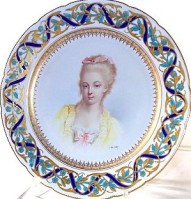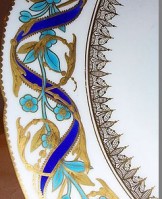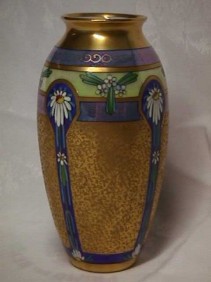
Plate with Roman gold and China painted scrollwork

closeup of scrollwork
QUESTIONS AND ANSWERS
|

Plate with Roman gold and China painted scrollwork |

closeup of scrollwork |
|
|
A. This is one of those questions with no definite answer. Many painters say no more than three times and specify that gold should never be fired hotter than the previous firing. Some report beautiful results at temperatures as high as cone 05 plus multiple fires at china painting temperatures of cone 018 to 015. Gold melts and begins to run at 1063 degrees centigrade, just slightly less than cone 04.
In my own tests, I have fired pieces with Roman gold decoration up to 7 times at cone 017 with no apparent change in the quality of the gold's appearance. However, when I fire liquid bright gold at cone 015 more than three times, I can see a darkening and thinning of the color. |

Pickard vase with Acid Etched Roman Gold |
|
|
|
A. Occasionally liquid bright gold will have cracks and craze lines in it after it is fired. There are three possible causes identified by painters. Some are of the opinion that firing too hot will cause it. Also, many feel that too heavy an application of gold will result in crazing. Some suggest that oil on the china surface will cause crazing.
What ever the cause, it is not consistent. In efforts to test these theories, I have not found firing too hot (cone 015) to cause crazing. In three tests, however, I found heavy applications to result in crazing on some parts of the surface, but not all. Deliberately contaminating the surface with turpentine (allowed to dry thoroughly), finger prints, wax and painting mediums with copaiba or fat oil, resulted in ruined color, but not crazing. It is highly likely the crazing actually occurs during the drying process and firing temperatures cause greater contraction of the LB gold medium, widening the hair line cracks already present. In my own tests, examination of the heavy application of LB gold with a magnifying glass revealed hair line cracks in the surface after the piece was dry, but before the piece was placed in the kiln.
Based on the above tests, the evidence suggests that crazing is more related to heavy thick applications than other causes. However, these other factors may also contribute to, or cause, crazing under certain circumstances.
(added by Marci Blattenberger) It has also been reported that firing Roman gold over fired green china paint will result in a crackled texture which can be used to advantage.. |
|
|
|
|
Some painters report discolorations on their gold if the kiln is not vented properly during the fire. Most recommend leaving at least one peep hole open during the entire firing period. Several painters have reported discoloration if liquid bright gold is applied over some types of unfired raised paste. Others report liquid bright gold turning dark over raised paste even after it is fired. All raised paste is not created equally and will not behave the same way. The rule of thumb here is to test any raised paste with your gold on a test tile or plate before using it on a major piece. Keep records of what works and what doesn't, so you aren't doomed to disappointment at some later time when your normally excellent memory has a "senior moment" and skips that critical bit of information. Experience seems to say that these dark spots cannot be repaired by painting more gold over it. Some painters report that if the gold and underlying material is removed with Whink, the spot can be successfully re painted. If you are using liquid bright gold, the mat area left after Whink, will be visible through the fired gold. If you want the repaired spot to be shiny, repaint the area with ivory glaze and re fire to at least 018 or 017 before applying the gold |
|
|
|
|
| Home/Mailing List/Membership/Charter Members-Sponsors/China Shows/China Studios/Antiquities Gallery/Library/Web Pages/Our Favorite Links |